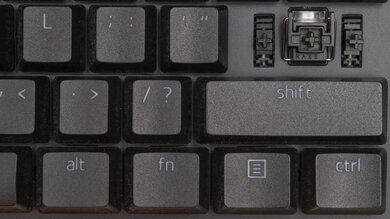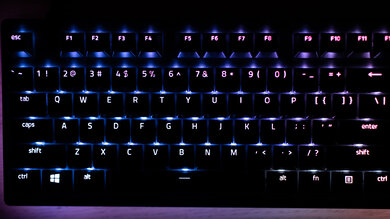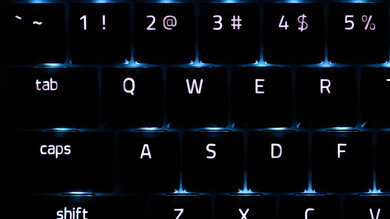The Razer Huntsman V2 Analog is an exceptional gaming keyboard that features Analog Optical switches. These switches allow you to adjust the pre-travel distance or 'sensitivity' of individual switches. You can also customize the switch reset point using 'Rapid Trigger' mode or enable an analog mode that mimics the feel of an analog joystick. This keyboard also has full RGB backlighting, macro-programmable keys, and a USB passthrough.
Note: We uncovered unexpected additional latency when testing this keyboard with its companion software running in the background. We recently highlighted this issue in our Test Bench 1.3 Changelog. For more details, see single key latency.
Our Verdict
The Razer Huntsman V2 Analog is an amazing gaming keyboard. It has very low and consistent latency, full RGB backlighting, and macro-programmable keys. It features Analog Optical switches that are easy to actuate, and it allows you to customize the pre-travel distance to your liking. You can also use its analog mode for finer movement control; however, it only works in games that support gamepads, and it might take a while to train your fingers to apply the appropriate amount of force.
-
Customizable pre-travel distance and low operating force.
-
Macro-programmable keys.
-
Full RGB backlighting.
-
Acceptable ergonomics.
-
Very low and consistent latency performance.
-
Analog mode only works if game supports gamepads.
The Razer Huntsman V2 Analog is great for office use. It has acceptable ergonomics and provides a light typing experience. However, its Analog Optical switches are linear and don't give any tactile feedback, making it harder to know if a keystroke is registered. Also, typing noise is on the louder side and might not be ideal for quiet offices.
-
Excellent typing quality.
-
Acceptable ergonomics.
-
Loud typing noise.
The Razer Huntsman V2 Analog is a wired-only keyboard that can't be used with mobile devices.
The Razer Huntsman V2 Analog is great for programming. It's very well-built, and it provides a light and comfortable typing experience. Every key is macro-programmable, and there's full RGB backlighting if you like working in the dark. Unfortunately, it's a wired-only keyboard with no multi-device pairing feature, which might disappoint those working on two computers. Also, while most keys work on macOS and Linux, there's no software for customization on those platforms.
-
Macro-programmable keys.
-
Full RGB backlighting.
-
Excellent typing quality.
-
Acceptable ergonomics.
-
Wired-only.
-
No multi-device pairing.
The Razer Huntsman V2 Analog is inadequate for use with a home theater PC. It's a wired-only keyboard, so you need to run a cable from the couch to your PC, which isn't ideal if you're worried about kids or pets tripping over wires. Also, there's no trackpad, which means you need a separate mouse to navigate the user interface. On the upside, it has dedicated media controls and backlighting.
-
Full RGB backlighting.
-
Wired-only.
-
No trackpad.
-
Large size.
This keyboard has amazing raw performance, with excellent single-key and multi-key latency. It also has full n-key rollover and an effective update rate of 1000Hz, providing an extremely responsive and consistent experience for gaming in any genre at a casual or competitive level.
- 8.7 Gaming
- 7.2 Office
- 0.9 Mobile/Tablet
- 7.8 Programming
- 3.8 Entertainment / HTPC
- 8.7 Raw Performance
Changelog
-
Updated May 15, 2025:
We've written text for the new Adjustable Input Granularity box, added with Test Bench 1.4, and we've made sure all text throughout the review reflects any changes.
- Updated May 15, 2025: We've updated this review with our new Test Bench 1.4 methodology. It adds a new Output Type classification in the Switches box, indicating whether the keyboard's output is non-adjustable, adjustable, or analog. It also introduces a new Adjustable Input Granularity test, which improves comparability between keyboards with adjustable input.
- Updated Jul 26, 2024: We've corrected an error in the Hardware Customizability section and changed the result of the Switch PCB Socket test from a Soldered to a Non-Customizable Design. We've also added new supporting text in this section.
- Updated Nov 29, 2023: We've added a link to the newly-reviewed Razer Huntsman V3 Pro to the Switches section of this review.
- Updated Nov 29, 2023: We've converted this review to Test Bench 1.3.1, which adds a new estimated PCB latency test to the Single-Key Latency section and a new Analog test to the Switches section of this review. You can see the full changelog here.
Check Price
Differences Between Sizes And Variants
We tested the Razer Huntsman V2 Analog in black, and there are no other variants. You can see our unit's label here.
Compared To Other Keyboards
The Razer Huntsman V2 Analog is an exceptional mechanical keyboard. However, its analog mode has some limitations, and it might take a long time to train your fingers to apply the appropriate amount of force, as most gamers are likely to bottom out the keys in the heat of the moment.
For more options, check out our recommendations for the best gaming keyboards, the best mechanical keyboards, and the best RGB keyboards.
The Razer Huntsman V2 Analog and the Razer Huntsman V3 Pro are wired gaming keyboards that use analog optical switches that allow you to customize individual keys' pre-travel and reset distance. The V3 Pro is newer and uses an updated version of these switches. It also provides better actuation and Rapid Trigger setting accuracy. Additionally, with the V3 Pro, you can enable Rapid Trigger without having the software running in the background, which isn't possible with the older V2 model.
The Razer Huntsman V2 and the Razer Huntsman V2 Analog are very similar boards, but each has unique features. The V2 is Razer's first board with an 8000Hz polling rate, and its latency is lower than the V2 Analog's. It's available with Razer Linear Optical and Razer Clicky Optical switches. On the other hand, the V2 Analog has Razer Analog Optical Switches, which you can set to act as an analog joystick. This makes the switches reactive to the amount of pressure you apply as you move the key downwards. The V2 Analog has a USB passthrough and an RGB strip that wraps around the sides of the board and the wrist rest.
The Razer Huntsman V2 Analog is essentially the Razer Huntsman Elite, but with Analog Optical switches as they're nearly identical in their exterior designs. The difference between the Analog Optical and the linear optical switch is that the Analog Optical has an adjustable pre-travel distance and lets you use the keyboard like an analog joystick. Also, it allows you to program the keys to perform two functions with one keypress. The Elite's linear optical switch requires less force to actuate, which is both a good and bad thing because even though it makes it easier to actuate, it's overly sensitive for general typing, leading to more typos.
The Razer Huntsman V2 Analog and the Wooting two HE are premium wired-only gaming keyboards with adjustable pre-travel distances and an analog mode that mimics joystick controls. However, the Wooting implements this technology much better than the Razer, as it performs more consistently and accurately. Also, the range in which you can adjust your pre-travel distance is much wider on the Wooting as it uses a different type of switch than the ones found in the Razer.
The Razer Huntsman V2 Analog and the Corsair K100 RGB are both exceptional wired gaming keyboards; however, they're also quite different. The Razer uses Analog Optical switches that can function like an analog joystick, and you can customize the pre-travel distance to your liking. On the other hand, the Corsair uses more traditional Cherry MX Speed switches and is available with Corsair OPX switches as well. That said, the Analog Optical and the Cherry MX Speeds are both linear switches that require about the same amount of force to actuate and don't provide any tactile feedback. Feature-wise, the Corsair has an extra column of dedicated macro keys that the Razer lacks and a dial that you can customize to perform various functions.
The Razer Huntsman V2 Analog and the Logitech G915 LIGHTSPEED are very different keyboards. The Razer is a wired-only keyboard that features Analog Optical switches, while the Logitech is a low-profile, wireless keyboard that's available with tactile, clicky, or linear switches. The Razer lets you customize the pre-travel distance, perform two actions in one keypress, or use the keyboard like an analog joystick. On the flip side, the Logitech has an extra column of dedicated macro keys and a multi-device pairing feature. The Logitech has better compatibility because it can be used with mobile devices and has software support for macOS.
The Razer Huntsman Tournament Edition and the Razer Huntsman V2 Analog are both fantastic gaming keyboards. They both come with linear optical switches, but the Tournament Edition has the Razer Linear Optical switches, while the V2 Analog has the Razer Analog Optical switches, which are a bit heavier to press but offer a much better typing experience. As the name suggests, the V2 Analog has a feature that allows you to control the keys like an analog joystick, providing greater control over fine movements. It's also a full-size option with a wrist rest, while the Tournament Edition is TKL and doesn't come with a wrist rest.
The Razer Huntsman V2 Analog and the Corsair K70 MAX are full-size gaming keyboards with analog switches that allow you to customize individual switches' pre-travel and reset points. Unfortunately, this setting is noticeably inaccurate on the Razer keyboard. That said, the Razer has somewhat better build quality. It also has a programmable control knob and a USB passthrough, which the Corsair lacks. On the other hand, the Corsair has a higher maximum polling rate of 8000Hz. It also has several extra features the Razer lacks, including a tournament switch, programmable scroll wheel, and dedicated profile, brightness, and lock keys.
The Razer Huntsman V2 Analog and the SteelSeries Apex Pro TKL (2023) are mechanical gaming keyboards with switches that allow you to adjust the actuation point of individual keys. The Razer is a full-size model that uses Razer Analog Optical switches. In addition to being able to adjust the actuation point, this keyboard also allows you to set an analog mode which makes keys mimic analog joystick controls. On the other hand, the SteelSeries has a smaller TKL (80%) form factor and has OmniPoint 2.0 switches. While these switches don't have an analog mode, the adjustable actuation points are more precise and predictable than those on the Razer, and you can adjust the action points within a wider range. The SteelSeries also has an OLED screen which the Razer lacks.
The Razer Huntsman V2 Analog and the Wooting 60HE are mechanical gaming keyboards with outstanding gaming performance and Hall effect analog switches that allow you to adjust the pre-travel on a per-key basis. The Razer is a full-size keyboard with an included wrist rest. On the other hand, the Wooting has a smaller, Compact (60%) form factor. The Wooting also includes several additional software features the Razer lacks, including a Rapid Trigger mode, a low latency Tacyhon Mode, the ability to assign up to four inputs to a single keypress, customizable reset points, and an Analog Mode that mimics the gradual input of a controller's joystick.
The Razer Huntsman V2 Analog and the ASUS ROG Claymore II are both full-size gaming keyboards, but the Razer is wired, and the ASUS is wireless. The ASUS has a modular numpad that you can place on either side of the board or remove it completely for a TKL size. Also, it has a volume control, a USB passthrough, four dedicated macro keys, a plushy wrist rest, and lower latency. You can use it wirelessly via its USB receiver, and it's available with linear and clicky ROG RX Optical Mechanical switches. On the other hand, the Razer has proprietary linear Razer Analog Optical switches, which let you use the keys like an analog joystick, and you can customize the pre-travel distance to your liking.
The Razer Huntsman V2 Analog and the Keychron Q1 HE are mechanical gaming keyboards with Hall effect switches that allow you to adjust individual switches' actuation and reset distance. The Razer is a larger, full-size model. It also includes a wrist rest, shine-through keycaps, and extra features like dedicated media keys and a USB passthrough. Comparatively, the Keychron is a small, compact (75%) model with added Wireless support. It also has significantly more lightweight web-based software, while the Razer has quite heavyweight, intrusive software. While both offer similarly premium-feeling typing quality, the Keychron's build quality more closely resembles a custom keyboard rather than a traditional gaming keyboard, as it has a full aluminum chassis and a gasket mount design that produces a softer, almost springy feeling while typing.
The Razer Huntsman V2 Analog and the SteelSeries Apex Pro Mini are both gaming keyboards with an adjustable pre-travel distance. The Razer is a full-size wired unit that uses Optical switches, while the SteelSeries is a compact (60%) keyboard with magnetized Hall Effect switches. The SteelSeries is more consistent with their implementation of this adjustable pre-travel distance feature, but the Razer has an Analog Mode, so keypresses emulate joystick controls on a gamepad.
The Razer Huntsman V2 Analog and the Razer BlackWidow V3 Mini HyperSpeed are both outstanding mechanical gaming keyboards. If you prefer full-size wired boards, the V2 Analog is a better choice. It has a Numpad, dedicated media keys, a volume control knob, a USB passthrough, and a detachable wrist rest. It's available with Razer Analog Optical Switches, which are linear and let you adjust the pre-travel distance. They also have an analog mode, which lets you use the keys like an analog joystick. On the other hand, the HyperSpeed is better if you prefer a 65% compact wireless board that can pair with up to three devices at once via Bluetooth. It's available with linear Razer Yellow and clicky Razer Green switches.
The Razer Huntsman V2 Analog and the SteelSeries Apex Pro are exceptional gaming keyboards with fairly similar features. Razer's Analog Optical and SteelSeries' Omnipoint switches are both linear with adjustable pre-travel distances. The difference is that the Analog Optical lets you program two actions in one keypress or use it like an analog joystick. Other than that, the SteelSeries has a customizable OLED screen and software support for macOS, which the Razer lacks.
The Razer Huntsman V2 Analog and the Razer BlackWidow Elite are very similar overall. The main difference is that the Huntsman has linear analog switches that let you use the keyboard like an analog joystick, while the BlackWidow uses more traditional mechanical switches and is available in three switch types, tactile, clicky, and linear. The only other difference is that the Huntsman has LED lighting on the sides to create an underglow effect. Both keyboards offer an excellent typing experience, but the Huntsman's switches might be too sensitive for some and might cause more typos.
The Razer BlackWidow V3 Pro and the Razer Huntsman V2 Analog are both outstanding full-size gaming keyboards. The Huntsman V2 is wired-only and comes with unique Analog Optical switches, which are very light to press and have a linear feel for a responsive gaming experience. They also have an analog feature, allowing you to use the keys like a joystick. The V3 Pro, on the other hand, is available with two types of mechanical switches, so you can get the ones you prefer, and it's wireless, so you can connect it with up to three devices at once.
Test Results
The Razer Huntsman V2 Analog is a larged full-size keyboard, and it takes up even more space if you use the wrist rest. If you'd prefer a more compact option that still has Analog switches, check out the Razer Huntsman Mini Analog.
The Razer Huntsman V2's build quality is excellent. It has a plastic frame reinforced with a metal plate that feels rigid, exhibiting little to no flex. The PBT keycaps are textured and feel high-quality, but not all the keys are stable as there's some rattle on the spacebar and right Shift. The feet aren't very grippy, so it's easy to move the keyboard around, but it's not bad enough to be an issue in regular use. The incline feet are stable and don't collapse when pushing the keyboard.
The Razer Huntsman V2 Analog has acceptable ergonomics. Without any incline setting, it naturally sits at a 3-degree angle. There are two incline settings, and it includes a leatherette wrist rest. It's comfortable to type on and shouldn't cause fatigue over time.
Note: The Razer Analog Optical Switches aren't soldered, and you can remove them from the PCB. However, we haven't classified these switches as hot-swappable because the switch PCB socket has a proprietary, non-customizable design, and Razer doesn't sell replacement switches.
The Razer Huntsman V2 has full RGB backlighting with individually-lit keys. Like the Razer Huntsman Elite, there are light strips on the sides of the keyboard and the wrist rest to create an underglow effect. The wrist rest has connectors to draw power from the keyboard, so you can't position it further away if you want the strips to light up. You can control the brightness directly on the keyboard, but you need the Synapse 3 software to customize the colors and effects.
The cable is braided and has two connectors, a USB-A and a USB-C. Both need to be connected to use the USB passthrough. If you don't have a USB-C port on your computer, a USB-C to USB-A adaptor is included in the box.
The Razer Huntsman V2 is a wired-only keyboard.
The Razer Huntsman V2 has many features. It has dedicated media controls at the top right corner of the keyboard and a USB-A passthrough on the left side. Every key is programmable through software, and you can also set macros on-the-fly.
The Razer Huntsman V2 Analog provides an excellent typing experience. The keys are stable, except for the spacebar and Right shift, which descend unevenly and rattle a bit. The PBT keycaps are textured and feel comfortable to type on. The keys are well-spaced, so it requires very little adaptation to type accurately. However, it isn't recommended to set the actuation point too low as it becomes overly sensitive and can lead to more typos. Also, there's no tactile feedback since the switches are linear. On the upside, typing on it feels light and responsive and shouldn't cause fatigue over time.
Even though the Razer Huntsman V2 Analog uses linear switches, typing noise is still on the loud side, so it might not be ideal for quiet office environments.
Razer's Analog Optical Switches are linear, which means they don't provide any tactile feedback, and they're very easy to actuate due to their light operating force. You can adjust the pre-travel distance from 1.5 mm to 3.6 mm; however, the results are very different from the actual settings. See the Adjustable Input Granularity test for more details.
The analog mode lets you use the keys like an analog joystick, which is meant to provide finer movement control in some types of games, like racing games, FPS, and flight sims. It makes the keys feel like pedals, so you move faster as the key travels downwards. However, this feature only works in games that support gamepads, and Synapse 3 has to be running in the background. Some games can only receive inputs from a controller or a mouse/keyboard combo, but not both at the same time. In this case, you have to remap all of the controller's functions to the keyboard for the analog mode to function properly and not use the mouse at all, as any mouse input can cause erratic movements in-game.
If you'd prefer a keyboard that has a more consistent application of this adjustable pre-travel distance feature, check out the SteelSeries Apex Pro Mini Wireless.
The Razer Huntsman V2 Analog exhibits poor input granularity. Despite its exceptionally small minimum step depth, it has inadequate detection ratio across the total key travel. It also has large deadzones and isn't particularly well-suited for producing quick and consistent initial and follow-up inputs for movement techniques like tap-strafing in FPS titles.
The keyboard supports true analog output and features a smooth, consistent displacement curve that corresponds reasonably well to the physical position of each key. This makes it a viable option for games that benefit from gradual input, such as racing sims, flight sims, and platformers.
This keyboard uses Razer Analog Optical switches. If you're interested in another keyboard in the same lineup that uses updated Razer Analog Optical Switches Gen-2 and provides more accurate actuation and reset point settings, see the Razer Huntsman V3 Pro.
This keyboard has superb single-key latency performance and delivers an extremely consistent and responsive-feeling experience for playing games in any genre at a casual or competitive level.
Razer added a 'Rapid Trigger' mode to this keyboard via a firmware update post-launch. This mode allows you to adjust the sensitivity of switch reset points, which Razer claims can allow you to release and repeatedly press keys much faster. This mode requires the Razer Synapse 3 configuration software running in the background to function.
The listed test results were achieved with the actuation point set to its lowest setting (1.5mm), with Rapid Trigger Disabled, and with this keyboard's configuration software, Razer Synapse 3, not running in the background. This was done intentionally, as this keyboard produces worse latency results with Razer Synapse 3 running in the background.
Additional latency with Razer Synapse 3: We conducted tests with the software running and with the Rapid Trigger mode enabled and disabled. In both cases, with the software running and with Rapid Trigger enabled or disabled, this keyboard produces a latency result of ~4.0ms higher than when Razer Synapse 3 is not running in the background.
We suspect that when the software is running, the Razer Huntsman V2 Analog no longer reports normally as a keyboard to your computer and, instead, acts as a raw position device that's read by its software. The software then processes the position of each switch and emulates a virtual keyboard to send key presses to the host, which adds considerable latency. With the software open, this keyboard sends 6 End Points per Input, as seen here. With the software not running, this keyboard only sends a single End Point per Input as seen here.
To ensure the lowest latency with this keyboard, we recommend not enabling the Rapid Trigger function and not running Razer Synapse 3 software in the background while gaming. Also, we haven't found that running Razer Synapse 3 in the background adds additional latency for any other Razer keyboard models. But this is something we'll be checking going forward.
This keyboard has amazing multi-key latency performance that's also very consistent, making it very well-suited for playing any games that require new inputs while multiple keys are already pressed and held down.
This keyboard has a 'Rapid Trigger' feature. For more details, see the Singe Key Latency section.
This test was conducted with the actuation point set to its lowest setting (1.5mm), with Rapid Trigger Disabled, and with this keyboard's configuration software, Razer Synapse 3, not running in the background.
This keyboard has excellent data transmission performance. It can send multiple keys per USB report and has full n-key rollover. It also has an effective polling rate of 1000Hz, making it capable of taking full advantage of its 1000Hz polling rate.
This keyboard has impressive and consistent chord split performance, with very low 4-chord delay and reasonably low 8-chord split delay, making it a good candidate for playing rhythm games requiring many simultaneous inputs.
The Razer Huntsman V2 Analog is customizable through the Synapse 3 software. In addition to customizing the backlight, you can adjust performance settings such as the actuation point and the debounce height. You can also program keys to perform two actions: one when the key is pressed, and the other when the key is released. Enabling the analog mode lets you use the WASD keys like an analog joystick, but it only works in games that support gamepads.
The Razer Huntsman V2 Analog has decent compatibility. On macOS, the Pause/Scroll Lock key doesn't work, and there's no software for customization. All keys work on Linux, but like macOS, there's no software support.
Comments
Razer Huntsman V2 Analog: Main Discussion
Let us know why you want us to review the product here, or encourage others to vote for this product.
Update: We’ve written text for the new Adjustable Input Granularity box, added with Test Bench 1.4, and we’ve made sure all text throughout the review reflects any changes.
- 21010
Pretty sure the switches aren’t actually soldered. You can pop them out, even without disassembling the keyboard, but it takes a bit of effort. The optical emitter and receiver seem to be on the PCB itself, which just shines through the switch. The switch itself purely mechanical, nothing electronic that would require soldering. You should probably double check the Huntsman V3 as well.
Hello giveprocs! Thank you for your feedback on this. You are indeed correct. We took apart our unit today and you can indeed remove the switches and see how they are purely mechanical.
We will edit the reviews for both Hunstman keyboards in the next few days.
- 21010
Pretty sure the switches aren’t actually soldered. You can pop them out, even without disassembling the keyboard, but it takes a bit of effort.
The optical emitter and receiver seem to be on the PCB itself, which just shines through the switch. The switch itself purely mechanical, nothing electronic that would require soldering.
You should probably double check the Huntsman V3 as well.
Update: We’ve added a link to the newly-reviewed Razer Huntsman V3 Pro to the Switches section of this review.



































